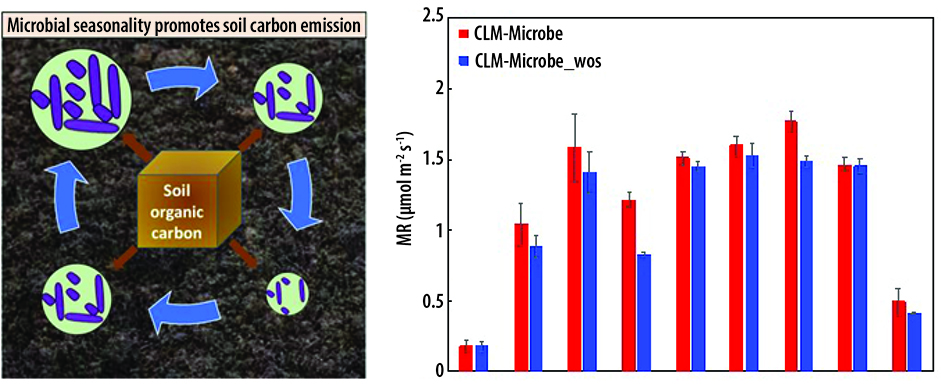May 10, 2021
Seasonal Fluctuations in Temperature and Moisture Lead to a Fluctuation in Soil Microbial Populations and Changes Soil Carbon Emissions
Modeling reveals increased carbon emissions are a result of high microbial fluctuation in soil

Conceptual diagram for microbial seasonality impacts on soil organic carbon (left); simulated microbial respiration (MR) in natural biomes (right). Bar groups (from left to right): deserts, grasslands, shrublands, boreal forests, temperate broadleaf forests, temperate coniferous forests, tropical/subtropical forests, wetlands, and tundra). CLM-Microbe represents the default model simulation with the seasonality of fungal and bacterial biomass; CLM-Microbe_wos indicates the model simulation scenario without the seasonality of fungal and bacterial biomass.
[Courtesy Xiaofeng Xu (left) and Liyuan He (right)]
The Science
Seasonality is a key feature of the biosphere, and the seasonal dynamics of soil carbon emissions represent a fundamental mechanism regulating the terrestrial–climate interaction. Scientists applied a microbial explicit model—CLM-Microbe—to evaluate the impacts of microbial seasonality on soil carbon cycling in terrestrial ecosystems. The scientists first validated the CLM-Microbe model in simulating belowground respiratory fluxes (i.e., microbial respiration, root respiration, and soil respiration from nine biomes). The research team then investigated the microbial seasonality effects on soil carbon cycle by comparing the model simulations of soil respiratory fluxes and soil organic carbon content in top 1 m between the CLM-Microbe model with (CLM-Microbe) and without (CLM-Microbe_wos) seasonal dynamics of soil microbial biomass in natural biomes.
The Impact
A modeling study shows fluctuating soil microbial populations promote carbon emission from soil. It suggests that the soil microbes, similar to our human body, would consume more energy in a more seasonally fluctuated climate. The study opens up a new frontier of the impacts of microbial activity at seasonal or finer timescale on soil carbon and nutrient processes.
Summary
The CLM-Microbe model produced good performance in capturing the seasonality in soil respiratory fluxes. Removing soil microbial biomass seasonality yielded minor impacts on root respiration, but it significantly increased the simulation bias and reduced the goodness-of-fit in microbial respiration and soil respiration. The model simulation without soil microbial seasonality led to lower soil respiratory fluxes across sites, leading to higher soil organic carbon pool size except for boreal-Arctic sites. These lines of evidence confirmed that microbial seasonality promotes soil carbon emission. The different roles of bacteria and fungi in regulating carbon flux suggest the important regulation of soil microbial community on belowground carbon biogeochemistry. Findings of the study highlight the importance of explicit representation of microbial mechanisms at the seasonal scale on simulated carbon cycling in Earth system models, insights which will both improve the simulation performance of soil respiratory fluxes and reduce the uncertainties associated with model projection in global carbon cycle under a changing climate.
Principal Investigator
Xiaofeng Xu
San Diego State University
xxu@sdsu.edu
Program Manager
Daniel Stover
U.S. Department of Energy, Biological and Environmental Research (SC-33)
Environmental System Science
daniel.stover@science.doe.gov
Funding
This study is supported by San Diego State University and the CSU Program for Education & Research in Biotechnology. Partial support for this work was provided by an Early Career Award through the Office of Biological and Environmental Research within the U.S. Department of Energy (DOE) Office of Science. Oak Ridge National Laboratory is managed by UT-Battelle, LLC, under contract DE-AC05-00OR22725 with DOE.
Related Links
- GitHub repository for CLM-Microbe
- EurekAlert!/AAAS news release: "In soil, high microbial fluctuation leads to more carbon emissions"
References
He, L. et al. "Microbial Seasonality Promotes Soil Respiratory Carbon Emission in Natural Ecosystems: A Modeling Study." Global Change Biology 27 (13), 3035–3051 (2021). https://doi.org/10.1111/gcb.15627.

